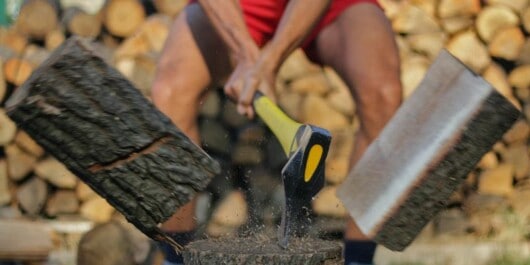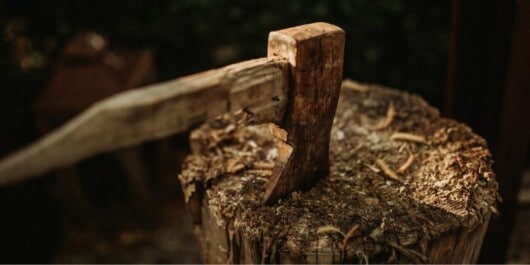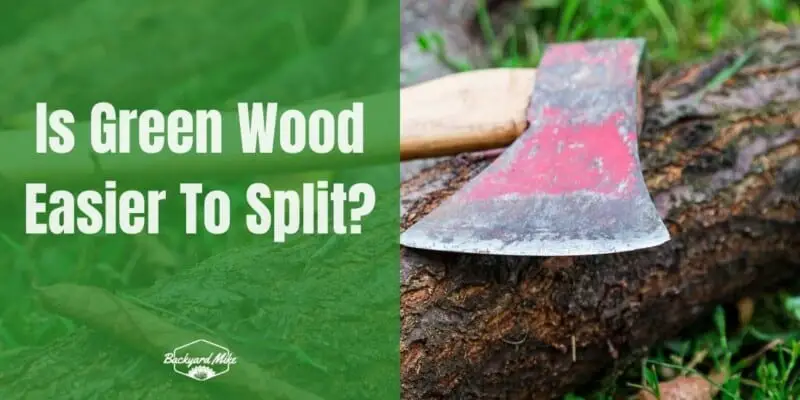Are you a homeowner who prefers splitting and gathering wood before the winter even starts? If yes, then you might be wondering if green wood is easier to split or dry wood. You will find out the answers here.
Green wood is easier to split, and it’s the better option, as most types of wood split the easiest when it is fresh. It would be smarter if you split the wood when it’s green and gather it for burning during the winter cold. This way, you’ll have to put less effort into cutting wood. Green wood contains a lot more moisture, which makes it softer and more yielding when being cut.
In this article, you’ll get to know all about splitting green wood, is green wood easier to split, is it better to split wood green or seasoned, the benefits of splitting green wood, what tools to use for splitting green wood, and more. Stick around to get all the answers that you’re looking for.
Benefits of splitting green wood
The mechanics of splitting green wood can be invigorating and leave you with a feeling of accomplishment. It’s important to use the right technique to increase efficiency and avoid personal injuries. A lot of frustration can arise from using bad techniques, so it’ll be best to do things the right way. Use a log splitter or a wood splitter’s maul instead of using an axe. A maul has a thicker wedge shape, which gives it a distinct advantage over a slim axe, as it’ll be less likely to get stuck in the wood. You’re essentially splitting the wood here and not cutting it.
First, cut the fallen tree into multiple rounds of manageable size. If you’re starting out, your rounds need to be approx. 12 inches in length. You can make the rounds longer once you’ve got more experience and confidence.
Inspect these rounds for any cracks or weaknesses, to use as your target. Then, put the piece on a chopping block if possible, and otherwise hard ground would do just fine. Aim for the center and be on the side closest to you. It’ll be better to be slightly short and land in the dirt than over-extending and hitting the handle on the piece of wood. Not only does it not feel good on the arms, but the handle will also have to be replaced if it happens repeatedly.
Stand square to the chopping area, raise the maul behind your head, and then bring it down with force. Engage your entire body – back and legs and not just the arms. Remember to look at the exact spot that you want to hit and not let your eyes wander. Moreover, focus on splitting the wood all the way to the bottom. It’ll make your stroke more powerful and intentional. When you’re finished, you should stack the split wood where air and sunlight can dry it. You will be ready to warm yourself during the winter once you’ve mastered this technique of splitting green wood.
Is it better to split green wood or seasoned?
If you’re splitting green wood manually, generally, wood will be easier to split when it is green. Green wood has a lot of moisture, which makes it softer and more yielding to your splitting tool.
This is even more true for deciduous trees like oak and maple. Many species of hardwoods tend to become extremely dense and solid once they dry out, which makes them a lot more challenging to split. While it’s still possible but you’ll need to spend more time and effort.

There are other advantages of splitting green wood as well. Once green wood is chopped into smaller pieces, the wood will dry rapidly. But if unsplit trees are cut with the bark on for a long time, they’ll likely start rotting on the outside before the center is dry. However, there are notable exceptions when it’s better to wait until the wood is dry. Many experienced wood splitters prefer splitting seasoned conifer wood, which happens to be sappy and too soft when it’s fresh. Letting pine and other similar woods dry before splitting will give the wood a chance to be brittle and easier to split. Other types of wood are notorious for being hard to split most of the time. Cherry and Elm are prime examples of that. Their entangled, twisted fibers don’t make for easy splitting. This is why you’ll need to spend more time and energy splitting this kind of wood.
If you’re using a hydraulic log splitter, you’re in a great position. You won’t have much trouble splitting wood whether it is green, seasoned, or otherwise.
What tools can be used for splitting green logs?
The traditional tool for splitting green wood is a wood splitter’s maul, compared to the household axe. A maul is just a wedge accompanied by a handle. The wedge design/shape has a steep slope, which prevents it from sticking to the wood. Axe heads come with a gentler slope. It is possible to split green wood using an axe, but it’ll be harder work. The steeper edge of the maul makes the wood split more easily as it generates outward pressure. This is especially important with green wood, which is a bit more flexible.
If you’re having tough wood that isn’t easy to split, then you should be using wedges and a sledgehammer. Try using the maul if possible, though. The entire process of putting the wedge in the right position and striking it with a hammer will take more time.
Contrary to popular belief, lighter mauls are a lot more efficient than heavier ones, as you’ll be able to swing them faster. When splitting wood, it’s the velocity of the head that actually matters. Energy is equivalent to the square of the velocity of the object. A fast maul head can generate more energy than a heavier one. Unless you are incredibly strong, you’ll work more efficiently with a lighter maul.
It will help if you can be elevated a bit compared to the wood that you’re splitting. This way, you can maximize the leverage that you’re benefiting from. You should be placing the round on a hard, level surface such that all your energy will go straight into the wood. Then, deliver the blow towards the outer edge of the rounds such that the head of the maul is hitting at an angle to the growth rings. It’ll make it easier for you to complete the split.
How to split green wood using a maul?
To swing, you should stand with your feet almost shoulder width apart and face directly towards the round. You need to be positioned such that you’ll strike the round in the right place when your arms are fully extended. Moreover, you need to be slightly bent over. Position the maul at waist level with your elbows bent. Have one hand towards the bottom of the handle while having your palms facing towards you. Meanwhile, the other one should be at the other end of the maul. Make sure that you’ve positioned your thumb next to the maul head. Changing positions and hands will relieve the strain of swinging the maul.

Slightly bend your knees, lean over, and lift the maul high over your head. Extend your arms high and then straighten yourself before allowing your hands to gently move lower on the handle. At the peak of the swing, start a strong downswing while focusing on the intended point of impact. Right before the head of the maul hits the green wood, pull the maul in toward yourself slightly. This will produce a strong and forceful blow that hits right where you want it to on the round of wood.
Conclusion
Thank you for reading. Hopefully, now you know a lot more about splitting green wood, is green wood easier to split, is it better to split wood green or seasoned, the benefits of splitting green wood, what tools to use for splitting green wood, and more. Green wood is easier to split, and it’s the better option, as most types of wood split the easiest when it is fresh. It would be smarter if you split the wood when it’s green and gather it for burning during the winter cold. This way, you’ll have to put less effort into cutting wood. Green wood contains a lot more moisture, which makes it softer and more yielding when being cut.


